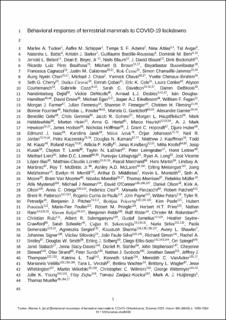Behavioral responses of terrestrial mammals to COVID-19 lockdowns
Tucker, Marlee A.; Schipper, Aafke M.; Adams, Tempe S.F.; Attias, Nina; Avgar, Tal; Babic, Natarscha L.; Barker, Kristin J.; Bastille-Rousseau, Guillaume; Behr, Dominik M.; Belant, Jerrold L.; Beyer Jr., Dean E.; Blaum, Niels; Blount, J. David; Bockmuhl, Dirk; Boulhosa, Ricardo Luiz Pires; Brown, Michael B.; Buuveibaatar, Bayarbaatar; Cagnazzi, Francesca; Calabrese, Justin M.; Cerne, Rok; Chamaillé-Jammes, Simon; Chan, Aung Nyein; Chase, Michael J.; Chaval, Yannick; Chenaux-Ibrahim, Yvette; Cherry, Seth G.; Cirovic, Dusko; Coban, Emrah; Cole, Eric K.; Conlee, Laura; Courtemanch, Alyson; Cozzi, Gabriele; Davidson, Sarah C.; DeBloois, Darren; Dejid, Nandintsetseg; DeNicola, Vickie; Desbiez, Arnaud L.J.; Douglas-Hamilton, Iain; Drake, David; Egan, Michael; Eikelboom, Jasper A.J.; Fagan, William F.; Farmer, Morgan J.; Fennessy, Julian; Finnegan, Shannon P.; Fleming, Christen H.; Fournier, Bonnie; Fowler, Nicholas L.; Gantchoff, Mariela G.; Garnier, Alexandre; Heim, Morten; Heurich, Marco Dietmar; Kaczensky, Petra; Kindberg, Jonas; Linnell, John Durrus; Meisingset, Erling L.; Van Moorter, Bram; Mysterud, Atle; Panzacchi, Manuela; Rolandsen, Christer Moe; Solberg, Erling Johan; Strand, Olav
Peer reviewed, Journal article
Accepted version

Åpne
Permanent lenke
https://hdl.handle.net/11250/3072878Utgivelsesdato
2023Metadata
Vis full innførselSamlinger
- Publikasjoner fra CRIStin - NINA [2364]
- Scientific publications [1392]
Sammendrag
COVID-19 lockdowns in early 2020 reduced human mobility, providing an opportunity to disentangle its effects on animals from those of landscape modifications. Using GPS data, we compared movements and road avoidance of 2300 terrestrial mammals (43 species) during the lockdowns to the same period in 2019. Individual responses were variable with no change in average movements or road avoidance behavior, likely due to variable lockdown conditions. However, under strict lockdowns 10-day 95th percentile displacements increased by 73%, suggesting increased landscape permeability. Animals' 1-hour 95th percentile displacements declined by 12% and animals were 36% closer to roads in areas of high human footprint, indicating reduced avoidance during lockdowns. Overall, lockdowns rapidly altered some spatial behaviors, highlighting variable but substantial impacts of human mobility on wildlife worldwide.
